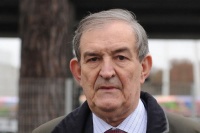Jean-Louis Bruguière
(French Juge d'instruction) | |
|---|---|
 | |
| Born | 29 May 1943 Tours, France |
| Alma mater | Sciences Po, École Nationale de la Magistrature |
Jean-Louis Bruguière is the former French investigating magistrate (Juge d'instruction) in relation to counter-terrorism. He was appointed in 2004 vice-president of the Paris Court of Serious Claims (Tribunal de Grande Instance). He has garnered controversy for various acts, including the indictment of Rwandan president Paul Kagame for the assassination in 1994 of Juvenal Habyarimana.
Washington Post journalist Dana Priest has cited him as saying that he had in the past ordered the arrest of more than 500 suspects, some with the assistance of US authorities. According to the investigative reporter, who described the workings of Alliance Base, a joint counter-terrorist operations centre, involving the DGSE, the CIA and other foreign intelligence agencies, Bruguière declared that he had "good connections with the CIA and FBI."[1]
Bruguière has since temporarily left his judicial functions to dedicate himself to politics, joining Nicolas Sarkozy's Union for a Popular Movement (UMP) conservative party. However, he was appointed by the European Union at the US Department of Treasury to oversee the Terrorist Finance Tracking Program.[2]
Contents
Biography
The latest in a long line of magistrates (eleven generations), Bruguière studied at the Institut d'Etudes Politiques de Paris and took part in the May 1968 protests. He continued his education at the École Nationale de la Magistrature. Appointed to Évreux, he made himself known through an affair involving illegal vehicle registration cards by naming the police director as the culprit. Appointed to Paris in 1976, he began an attack on local pimps (in particular the Madame Claude network), eventually having to work under police protection.
In 1982 Bruguière declared accused Japanese cannibal Issei Sagawa unfit to stand trial by reason of insanity and Sagawa was extradited from France to Japan where he was eventually released.[3]
Counter-terrorism
Following street gunfire in 1982, Bruguière turned himself towards counter-terrorism, expanding his network and targeting in particular the far-left group Action Directe. In 1986 a counter-terrorism division was formed in Paris. A year later his apartment was targeted in a grenade attack; Bruguière, however, continued his fight. In 1994, he tracked down and captured one of the world's most wanted terrorists, Ilich Ramírez Sánchez (Carlos the Jackal).[4]
Biggest case
Possibly his biggest case (in terms of number of people involved) was that of UTA Flight 772 which was sabotaged over the Sahara Desert in 1989 with the loss of 170 lives. Bruguière was instrumental in having six Libyans prosecuted in Paris and convicted in absentia. However, in the 2001 book Manipulations Africaines, he was accused by the French journalist Pierre Péan of having deliberately ignored evidence pointing to Lebanon, Syria and Iran in order to put the blame on Libya.[5]
Juge Bruguière's conclusions
- 20 September 1990: The UTA families (technically the partie civiles) are told by Jean-Louis Bruguière, the examining magistrate (investigator) into UT-772 that Congolese and Libyan elements are being sought over the atrocity.
- 21 September 1991: The Juge accuses 4 Libyan government officials of the destruction of UT-772 by a bomb. It is a timer bomb carried on board the aircraft by a Congolese mule who died unknowing of the contents of his baggage.
- October 1991: The Juge brings formal charges against the four Libyans.
- early 1990s: France, the UK and US work together and bring in UN sanctions against Libya in respect of the two atrocities UTA Flight 772 and Pan Am Flight 103. UN Security Council Resolution 748, adopted unanimously on 31 March 1992, introduced mandatory sanctions calling upon Libya to comply with requests to hand over two Libyan suspects in the destruction of Pan Am Flight 103 over Lockerbie on 21 December 1988 and to cooperate with the investigation of the sabotage of UTA Flight 772 over Chad and Niger on 19 September 1989.[6]
- 1996: The French Juge adds two more names to this charge sheet over UT-772, closes his file and passes it to the Parquet of the Paris court of Grand Instance (Paris County Court Prosecutor).
- 1997-9: The Libyans refuse to release 6 of their citizens for a trial in France and the French proceed with a trial in contumacy (in absentia), a process permitted by French law. In a three-day trial before a bench of about 15 judges the prosecution presents the equivalent of what would be the opening prosecution speech in an English court. Partie civile lawyers representing the relatives of the deceased passengers and crew and the airline company make their submissions. The six Libyans are sentenced to life imprisonment:
- Abdullah al-Senussi, brother-in-law of Muammar Gaddafi, and deputy head of Libyan intelligence;
- Abdullah Elazragh, Counsellor at the Libyan embassy in Brazzaville;
- Ibrahim Naeli and Arbas Musbah, explosives experts in the Libyan secret service;
- Issa Shibani, the secret agent who purchased the timer that allegedly triggered the bomb; and,
- Abdelsalam Hammouda, Senussi's right-hand man, who was said to have coordinated the attack.
References
- ↑
{{URL|example.com|optional display text}} - ↑ Article 29 Working Party "Press Release - Hearings of SWIFT representatives and Judge Bruguière", 8 April 2009
- ↑ Morris, Steven (September 20, 2007). "Issei Sagawa: Celebrity Cannibal". New Criminologist, the On-line Journal of Criminology. New Criminologist. Retrieved July 26, 2009.Page Module:Citation/CS1/styles.css must have content model "Sanitized CSS" for TemplateStyles (current model is "Scribunto").
- ↑ Follain, John (1998). Jackal: The Complete Story of the Legendary Terrorist, Carlos the Jackal. Arcade Publishing. p. 1. ISBN 1-55970-466-7.Page Module:Citation/CS1/styles.css must have content model "Sanitized CSS" for TemplateStyles (current model is "Scribunto").
- ↑ Les preuves trafiquées du terrorisme libyen
- ↑ United Nations Security Council Resolution 748 31 March 1992